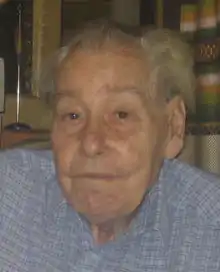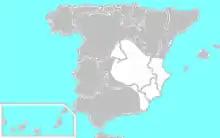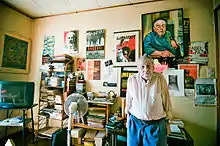Abel Paz
Abel Paz (1921–2009) was a Spanish anarchist and historian who fought in the Spanish Civil War. He is considered one of the noted Spanish anarchist historians,[1] writing multiple volumes on anarchist history, including a biography of Buenaventura Durruti, an influential anarchist during the war. He kept the anarchist tradition throughout his life, including a decade in Francoist Spain's jails and multiple decades in exile in France.
Abel Paz | |
|---|---|
 Abel Paz (2007) | |
| Born | Diego Camacho Escámez August 12, 1921 Almería, Andalusia, Spain |
| Died | April 13, 2009 (aged 87) Barcelona, Spain |
| Other names | Abel Paz |
| Occupation | Anarchist, writer, historian |
| Known for | Spanish anarchist, anti-fascist, biographer of Durruti |
Background
Abel Paz was born Diego Camacho Escámez[2] on August 12, 1921, in Almería, southeastern Andalusia, Spain. When he was six years old, he moved in with his Barcelonan uncle, who was a member of the Confederación Nacional del Trabajo (CNT), a Spanish anarcho-syndicalist labor union. Before his teens, Paz had joined the libertarian Ferrerist school Escuela Natura in Barcelona's El Clot working class district. He moved back briefly to Almería, where his mother was, too, a CNT member and subscribed to the Libertarian Youth in 1935.[3]
Career
Spanish Civil War
By February 1936, Paz had returned to Barcelona just before the start of the Spanish Revolution and Civil War. He participated in the resistance after Francisco Franco's 1936 pronunciamento.[4] He joined the CNT-FAI (allied with the Federación Anarquista Ibérica, founded as a group that fought the CNT-FAI's moderate policies, and fought for the working class and anarchists. Following his 1937 arrest in a clash with Stalinists, he worked in a farm collective, wrote for the FAI's Tierra y Libertad periodical, and fought on the Catalan front.
Post-war

As the war approached its end in early 1939, when Franco's Nationalists retook Catalonia, Paz and hundreds of thousands of anarchists sought asylum in France. In 1942, he returned to Catalonia and attempted to restart the CNT. He was jailed and passed between prisons for five years. Shortly after his release, he was jailed again for another five years for participating in the Libertarian Youth.
Exile
After his release in 1952, Paz returned to the resistance and became the underground organization's delegate to the 1953 International Congress.[3]
Paz remained exiled in France, where he traveled and participated in anti-Francoist, CNT, and Libertarian Youth groups. His partner Antònia Fontanillas (also of anarchist lineage) traveled with him through 1958. Over the next decade, Paz wrote multiple history books, including a biography of CNT figure Buenaventura Durruti, known as the most comprehensive account as of the late 2000s. His work covering Durutti covered an explanation of the failure of Durutti's militia to take Zaragoza after the capture of Bujaraloz.[2]
Return
In 1975, Francisco Franco died. In 1979, Paz returned to Spain and its anarchist movement. He wrote a four-volume memoir and spoke with young libertarians about his experiences. In the mid-1990s, Paz toured Italian public meetings following interest in Ken Loach's 1995 film about the Spanish Civil War, Land and Freedom. He participated in media accounts of the war through his physical decline and death.[3]
Personal and death

Paz's life partner was Antònia Fontanillas.
He died age 87 on April 13, 2009, in Barcelona.
Selected works

- La Barcelona Rebelde: Guía De Una Ciudad Silenciada Octaedro, 2003. ISBN 978-84-8063-628-5
- Durruti en la Revolución Española. Fundación Anselmo Lorenzo, 1996.
- Durruti in the Spanish Revolution. AK Press, 2006. ISBN 978-1-904859-50-5. Translated by Chuck W. Morse.[5][6][7][8]
- Durruti: the people armed. Black Rose, 1976. ISBN 978-0-919618-74-9 (pbk.) ISBN 978-0-919618-73-2 (hbk.)[9]
- The Spanish civil war. Hazan, 1997. ISBN 978-2-85025-532-8
- The Story of the Iron Column: Militant Anarchism in the Spanish Civil War. AK Press and Kate Sharpley Library, 2011. ISBN 978-1-84935-064-8. Translated by Paul Sharkey.[10]
References
- Davis, Mike (2007). In Praise of Barbarians: Essays against Empire. Chicago, IL: Haymarket Books. p. 265. ISBN 978-1931859-42-4.
- Alexander, Robert (1999). The Anarchists in the Spanish Civil War, Volume One. London: Janus Publishing Company. p. 161. ISBN 978-1-85756-400-6.
- Venza, Claudio (June 2009). "Remembering Diego Camacho AKA Abel Paz". KSL: Bulletin of the Kate Sharpley Library (58–59).
- Cacucci, Pino (1996). Camminando: incontri di un viandante (in Italian). Milan: Feltrinelli Editore. p. 79. ISBN 88-07-17016-7.
- Jackson, Hunter (September 2009). "Durruti in the Spanish Revolution By Abel Paz and Chuck Morse". WorkingUSA. 12 (3): 526–529. doi:10.1111/j.1743-4580.2009.00254.x. ISSN 1089-7011.
- "Durruti en la Revolución española (Book)". International Review of Social History. 42 (2): 335. August 1997. ISSN 0020-8590 – via EBSCOhost.
- Ealham, Chris (2009). "Rev. of Durruti in the Spanish Revolution". Anarchist Studies. 17 (1). ISSN 0967-3393 – via Book Review Index Plus.
- Alexander, Richard. "Review: Durruti in the Spanish Revolution". Black Flag. Retrieved October 16, 2017.
- Woodcock, George (April 28, 1978). "The Libertarian Virtues". The Times Literary Supplement: 477. ISSN 0307-661X.
- Pinta, Saku (2014). "Rev. of The Story of the Iron Column: Militant Anarchism in the Spanish Civil War". Anarchist Studies. 22 (1). ISSN 0967-3393 – via Book Review Index Plus.
Further reading
- Balanzà, Albert (April 24, 2009). "Mor l'històric dirigent anarquista Abel Paz, veí del carrer Verdi" (PDF). L'Independent de Gràcia. p. 5. Archived from the original on June 24, 2010.CS1 maint: bot: original URL status unknown (link)
- Bernecker, Walther L. (1998). "Review of Durruti 1896-1936". Notas: Reseñas iberoamericanas. Literatura, sociedad, historia. 5 (1): 155. ISSN 0945-8301. JSTOR 43112810.
- "Buenaventura Durruti 1896-1936 (Book)". International Review of Social History. 46 (2): 319. August 2001. ISSN 0020-8590 – via EBSCOhost.
- "CNT 1939-1951. El anarquismo contra el Estado franquista (Book)". International Review of Social History. 48 (1): 157. April 2003. ISSN 0020-8590 – via EBSCOhost.
- Guillamón, Agustín (February 2010). "Abel Paz, Anarchist and Historian". KSL: Bulletin of the Kate Sharpley Library (61).
- "La cuestión de Marruecos y la República española (Book)". International Review of Social History. 47 (1): 175. April 2002. ISSN 0020-8590 – via EBSCOhost.
- "Remembering Diego Camacho AKA Abel Paz". Anarcho-Syndicalist Review (53): 47. 2010. ISSN 1069-1995 – via EBSCOhost.